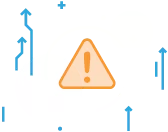It’s absolutely possible to have never heard of the Mastercard MATCH list until you’ve been placed on it. And being placed on it can be a merchant’s worst nightmare. The MATCH list, formerly known as the Terminated Merchant File (TMF), is a sort of blacklist that financial institutions often check before extending services to merchants.
Businesses, especially high-risk businesses, are placed on the MATCH/TMF list by engaging in fraudulent activity, defaulting on debt, accumulating too many chargebacks, or violating the terms of their merchant agreement.
Below, learn exactly what the MATCH list is, how to know if you’re on it, how it affects merchants, and how to get off of it.
What Is the Mastercard MATCH List?
Mastercard created and manages the Member Alert to Control High-Risk Merchants list, more commonly known as the Mastercard MATCH list. It is a detailed electronic database of merchants Mastercard has determined to be high-risk. This list is accessible through Mastercard Connect, 7 days a week, 24 hours a day.
Why do banks use this data?
In order to avoid partnering with merchants considered high-risk, banks and registered third-party processors screen merchants through the MATCH list. This is a quick way to verify whether a merchant has a history of poor business activities or has ever had their ability to process payments revoked. Financial institutions rely on this list to control the level of risk they expose themselves to when providing services to merchants. However, it is solely up to the financial institution whether or not it rejects an application based on the information found on the Mastercard MATCH list.
Mastercard and other financial institutions can either add or remove businesses from the proprietary MATCH list database. However, only the entity that puts a merchant on the list can remove that merchant from the list. Mastercard also has this power, but rarely manages other banks’ merchants.
Payment processors may contact the bank or servicer that put the merchant on the list and ask why. With this information, they will determine whether to accept or reject a merchant’s application. They may also decide to accept a merchant under certain restrictions.
What Is the Terminated Merchant File (TMF)?

The Terminated Merchant File (TMF) is a database of merchants that financial institutions have marked as high-risk. The Mastercard MATCH list is essentially just a newer, rebranded version of the TMF, thus many use these terms interchangeably.
Being on TMF makes it very difficult for a merchant to find another servicer willing to process their payments. The main reason why your business may end up on the TMF is repetitive or excessive chargebacks.
During underwriting and due diligence, processors run a check against the TMF/MATCH list, also known as a TMF inquiry. If the merchant is on the list, then the application will be declined.
Reasons Merchants End up on the MATCH List
A financial institution may add a merchant to the Mastercard MATCH list for a variety of reasons. Each added merchant is assigned a code, which indicates the reason they were added to the list. The most common reason merchants end up on the list is due to too many chargebacks, so it’s best to learn how to prevent chargebacks.
Below is a list of MATCH reason codes:
01: Account data compromise
02: Common point of purchase
03: Money laundering
04: Processing excessive chargebacks
05: Excessive fraud
06: Reserved for future use
07: Fraud conviction
08: Questionable merchant audit program
09: Filing for bankruptcy, liquidation, or insolvency
10: Violation of standards
11: Merchant collusion
12: Noncompliance with PCI data security standards
13: Illegal transactions
14: Identity theft
Is it possible to have your account flagged by accident?
Yes, but it’s not common. Sometimes a merchant might find themselves on the Mastercard MATCH list because of a clerical error or misunderstanding. In most cases, a merchant won’t even know they are on the list until they can no longer process credit card payments.
A merchant that thinks their business was placed on the MATCH list by mistake should call or email a company representative to make their case. The company will likely investigate the circumstances. If it was indeed an error, they will make a correction.
How Does Being on the TMF or Match List Affect Merchants?
The Mastercard MATCH list is a gatekeeper of sorts that keeps detailed records on each merchant on the list. The business, its owner’s name, address, and other details, including when and why it was added to the list, can all be found on the MATCH list.

Financial institutions consider some reasons for inclusion on the MATCH list to be worse than others. In particular, many financial institutions will hesitate to provide services to a business that has had its merchant account terminated. That business may have difficulty offering credit card payment options to their customers.
“Merchants who have been flagged have difficulty finding banks and payment processors who will work with them. Businesses might fold under this financial strain long before reaching the five-year mark when the entry is removed,” says Suresh Dakshina, president and co-founder of Chargeback Gurus.
Reportedly, Mastercard issued roughly one card for every resident of the United States in 2021.[1]Statista.“ “U.S. Credit Cards – Statistics & Facts”. Accessed April 28, 2022. In 2019, the total value of credit card transactions was 3.9 trillion U.S. dollars.[2]Statista. “Value of Credit and Debit Card Transactions in the United States in 2012 to 2019”. Accessed April 28, 2022. Losing the ability to process credit cards can cripple a merchant reliant on offering this form of payment to its customers.
How to Avoid Being Placed on the MATCH List
To avoid being placed on the Mastercard MATCH list, merchants should comply with their merchant agreement’s standards and regulations. Monica Eaton-Cardone, COO of Chargebacks911 says, “The simplest solution to ensure you don’t end up on the MATCH list is to immediately address whatever concerns led the acquiring bank to add your business to the list in the first place. This will go a long way toward stabilizing your reputation with cardholders and banks, and help repair your relationship with payment processors.”
Avoid partnering with payment service providers
Payment service providers, such as Stripe and Square, have become an increasingly popular payment processing solution due to their simplicity and speed with which they allow you to being accepting payments. But that speed sometimes comes at a high cost. Many payment service providers immediately approve merchants to begin processing, only to review their application after the fact. When the review is finally conducted, sometimes months later, they may reject an application for a variety of reasons. In such event, the termination of your Stripe account may land you on the MATCH list and/or TMF, all because the company didn’t perform its due diligence upfront.
It’s easy to avoid an unnecessary Square account deactivation and possibility of being added to MATCH/TMF simply by partnering with a traditional payment processor that reviews your application and underwrites your account before issuing their services.
How to Check if You Are on the MATCH List
If a financial entity feels it has reason to add a merchant to the list, it must do so within five days of the associated event. In most cases, TMF merchants won’t even know if they are on the list. The best way to find this out is to contact the company that terminated your merchant account to ask them if they put your name on the list, as well as how you can rectify the problem.
How to Get off the MATCH List
If, for example, a merchant is added for reason code 12—Noncompliance with PCI data security standards—they may be removed once they achieve compliance. However, a merchant must wait roughly five years to get off the list for all other violations unless it was added by mistake.
Note: Only the processor who placed your business on the MATCH list can take you off of it.
How to Secure MATCH List Credit Card Processing
Being added to the Mastercard’s database and/or TMF is frustrating. However, this doesn’t have to mark the end of your business. Yes, many entities will deny extending their merchant services to your business. However, there are many other merchant service providers that specialize in high-risk merchant accounts. By partnering with a provider specializing in high-risk, you may be able to obtain a TMF merchant account.
Alternative Payment Options for Merchants on MATCH
If you’re found to be in violation of your merchant agreement, you may circumvent finding a credit card payment processor altogether if it’s proving to be too difficult. Below are two alternative payment options that high-risk merchants may accept in lieu of credit cards.
eCheck
There are many benefits of eCheck payment processing, especially for businesses utilizing recurring payments and/or subscription services. In regards to high-risk businesses, eCheck payments do not require a merchant account, as the transaction funds deposit directly into their business bank accounts. If you are having difficulty obtaining a merchant account, eChecks are an excellent payment option to consider.
Cryptocurrency
Cryptocurrency transactions are a peer-to-peer transfer between the users’ wallets. As such, cryptocurrency funds aren’t deposited into a merchant account, but directly into the merchant’s crypto wallet. Like eChecks, this bypasses the need for a merchant account. Of course, the downside of cryptocurrency is that it’s subject to more volatility than national currencies. But for businesses unable to obtain a merchant account, and especially those with a target demographic that has embraced cryptocurrencies, this modern payment method may just be the way to go.
Closing Thoughts:
The Mastercard MATCH database and Terminated Merchant File are tools to help merchant service providers avoid partnering with high-risk merchants. Once on the list, it is difficult to get off, even if a merchant cleans up its act in order to remain in compliance with every rule of its merchant agreement. However, this doesn’t have to be a nail in the coffin of your business. Businesses on these lists may obtain a high-risk merchant account, as well as other high-risk merchant services, from providers specialized and experienced in partnering with high-risk businesses.
FAQs
How does the Mastercard MATCH list work?
Acquiring banks and processing companies register for an account on Mastercard Connect. During the merchant onboarding process, they submit an inquiry to see if the merchant has violated any terms of service in their agreement. If so, the entity can further research the merchant and decide to approve or deny its application.
What does MATCH stand for?
MATCH is an anagram for Member Alert To Control High-Risk Merchants.
Who puts merchants on the MATCH or TMF List?
Mastercard created and manages the MATCH and TMF lists. Acquiring banks, third-party payment processors, and Mastercard can put merchants on these lists.
How long will a merchant remain in the MATCH or TMF database?
It can be very difficult to get off the MATCH/TMF database. In most cases, merchants are on the list for at least five years. The only exception is if a merchant added for code 12 becomes compliant with PCI data security standards.






